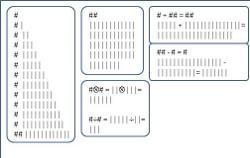I’m looking to update a pic from the book, the one with the first page of the language translation book for the Planet Movers. But if we put a higher-resolution image in the printed book, the graphic needs something more detailed than :
Any font / language fanatics out there that would like to help create the actual symbols for the PM language?

I’ve done some font file creation from existing shapes, but I haven’t tried designing one from scratch. That sounds like fun, I might want to give it a stab.
Actually, there are two parts to it: constructing the script, which is really just a sketch pad exercise, and converting the resulting sketches into actual finished font designs.
There are a bunch of existing scripts that could be used for inspiration. Made up ones like Klingon or the one from Lord of the Rings. Or real ones that are obscure: Linear B, Easter Island script, the Phaistos disk, Cherokee, Inuit syllabary, Syriac, some Indonesian scripts… lots of options. You might take a look at some, Wikipedia is likely to have a lot of examples.
Most of those don’t have upper/lower case (for letters) so that would be an additional exercise. And none have upper/lower case digits, that’s not an earth language concept as far as I know (but it is a really neat idea).
To produce an illustration for the book we only need the glyph designs (and not even a full alphabet, just whatever characters are on the one page).
If Rolf feels like creating more elaborate sections of the PM book, I would happily use them as part of the cover design when we do the print edition.
Ok. I re-read the section where that picture goes, and another that has more info. Language might be invented, might not be. Suppose it’s not. And the glyphs are evolved, not created (as in Korean or Inuit).
52 letters per case? That’s a lot for an alphabet. Or was that supposed to be two scripts? The text is unclear, it mentions English plus Greek which adds up to around 52, but English alone is nowhere near even if you have separate letters for the diphthongs. Some other languages have more sounds, though (like the languages of the Caucasus).
Ok so far?
“512 total symbols; 12 digits, 52 letters, upper and lower case for each. There are 128 basic letters and numbers, 384 symbols for the math and science”
The first part of the book would be just the math starting point. So the English equivalent in base 12 would be (using A=10, B=11, so 10=12)
0
1 |
2 ||
3 |||
4 ||||
5 |||||
6 ||||||
7 |||||||
8 ||||||||
9 |||||||||
A ||||||||||
B |||||||||||
10 ||||||||||||
48
||||||||||||
||||||||||||
||||||||||||
||||||||||||
||||||||
5+ 13 = 18
||||| + |||||||||||||||=
||||||||||||||||||||
15 – A = 7
||||||||||||||||| – ||||||||||= |||||||
2×3 = ||x|||= ||||||
6/2 = 3 ||||||/||= |||
So we’d really just need a reasonable 12 “upper case” digits and a couple of symbols (add, subtract, multiply, divide). The tally marks are fine as-is.
I like the look of the elvish and dwarfish runes in Tolkien, and Tamil scrip here on the Real Earth, and the consistency of Babylonian numbering system, but I suspect the numbers should be reasonably simple, have some sort of consistent look, and difficult to confuse one from another if sloppily written or well-worn. The zero might well look the same.
12 upper case numerals for known/certain values, 12 more “lower case” digits for rounded/approximate numbers.
52 letters, one for each sound. No duplicates (c/k, c/s, f=ph=ough, for example), long/versus short uses (tat versus tate), or multiple-letter sounds (th, ch, ing) etc. English has something like 45 phonemes, and other languages have somewhat more or less, but in the same neighborhood. I figured a bit more than that, but not a lot. Upper and lower case are not distinguished for pronunciation, but for other grammatical purposes, such as proper names, case (in the Latin sense), etc.
Ok, I have made up a set of digits and some math symbols, and an inventory of vowel and consonant sounds, by stealing from a couple of different languages. With distinct glyphs for diphthongs, long/short vowel forms, etc., I got 17 vowel/diphthong characters. Thrown in consonants from English plus some others, and I’m nearly there.
I figure upper/lower case pairs are often quite similar with a more or less consistent recipe for converting one to the other. But not always. Consider English o and O (size), i and I (size and dot) but a and A or e and E which show shape change.
This high-speed train travels at the speed of 350 kph from Madrid to
Barcelona. Beginning on the Plaza de Cascorro, vendors line the streets on Sunday mornings,
selling sets from antiques, leather wares, imported items, and textiles
to clothing, souvenirs, and paintings. If you do go
mad the queue, the road vendor opposite sells beer.